
A chromosome is a deoxyribonucleic acid (DNA) molecule with part or all of the genetic material (genome) of an organism. Most eukaryotic chromosomes include packaging proteins which, aided by chaperone proteins, bind to and condense the DNA molecule to prevent it from becoming an unmanageable tangle.
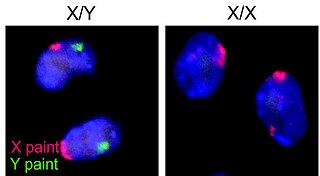
A gamete is a haploid cell that fuses with another haploid cell during fertilization (conception) in organisms that sexually reproduce. In species that produce two morphologically distinct types of gametes, and in which each individual produces only one type, a female is any individual that produces the larger type of gamete—called an ovum —and a male produces the smaller tadpole-like type—called a sperm. In short a gamete is an egg or a sperm. This is an example of anisogamy or heterogamy, the condition in which females and males produce gametes of different sizes. In contrast, isogamy is the state of gametes from both sexes being the same size and shape, and given arbitrary designators for mating type. The name gamete was introduced by the Austrian biologist Gregor Mendel. Gametes carry half the genetic information of an individual, one ploidy of each type, and are created through meiosis.
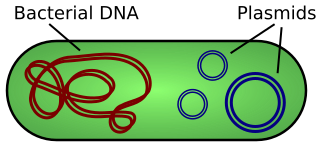
A plasmid is a small DNA molecule within a cell that is physically separated from chromosomal DNA and can replicate independently. They are most commonly found as small circular, double-stranded DNA molecules in bacteria; however, plasmids are sometimes present in archaea and eukaryotic organisms. In nature, plasmids often carry genes that benefit the survival of the organism, such as by providing antibiotic resistance. While the chromosomes are big and contain all the essential genetic information for living under normal conditions, plasmids usually are very small and contain only additional genes that may be useful in certain situations or conditions. Artificial plasmids are widely used as vectors in molecular cloning, serving to drive the replication of recombinant DNA sequences within host organisms. In the laboratory, plasmids may be introduced into a cell via transformation.

Organisms of many species are specialized into male and female varieties, each known as a sex. Sexual reproduction involves the combining and mixing of genetic traits: specialized cells known as gametes combine to form offspring that inherit traits from each parent. The gametes produced by an organism define its sex: males produce small gametes while females produce large gametes. Individual organisms which produce both male and female gametes are termed hermaphroditic. Gametes can be identical in form and function, but, in many cases, an asymmetry has evolved such that two different types of gametes (heterogametes) exist.
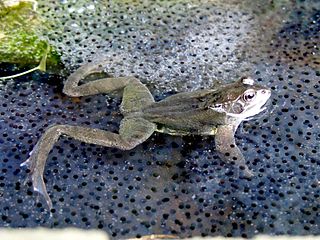
In biology, offspring are the young born of living organisms, produced either by a single organism or, in the case of sexual reproduction, two organisms. Collective offspring may be known as a brood or progeny in a more general way. This can refer to a set of simultaneous offspring, such as the chicks hatched from one clutch of eggs, or to all the offspring, as with the honeybee.

Genetic recombination is the exchange of genetic material between different organisms which leads to production of offspring with combinations of traits that differ from those found in either parent. In eukaryotes, genetic recombination during meiosis can lead to a novel set of genetic information that can be passed on from the parents to the offspring. Most recombination is naturally occurring.

The Y chromosome is one of two sex chromosomes (allosomes) in mammals, including humans, and many other animals. The other is the X chromosome. Y is the sex-determining chromosome in many species, since it is the presence or absence of Y that determines the male or female sex of offspring produced in sexual reproduction. In mammals, the Y chromosome contains the gene SRY, which triggers testis development. The DNA in the human Y chromosome is composed of about 59 million base pairs. The Y chromosome is passed only from father to son. With a 30% difference between humans and chimpanzees, the Y chromosome is one of the fastest-evolving parts of the human genome. To date, over 200 Y-linked genes have been identified. All Y-linked genes are expressed and hemizygous except in the cases of aneuploidy such as XYY syndrome or XXYY syndrome.

A cloning vector is a small piece of DNA, taken from a virus, a plasmid, or the cell of a higher organism, that can be stably maintained in an organism, and into which a foreign DNA fragment can be inserted for cloning purposes. The vector therefore contains features that allow for the convenient insertion or removal of a DNA fragment to or from vector, for example by treating the vector and the foreign DNA with a restriction enzyme that cuts the DNA. DNA fragments thus generated contain either blunt ends or overhangs known as sticky ends, and vector DNA and foreign DNA with compatible ends can then be joined together by molecular ligation. After a DNA fragment has been cloned into a cloning vector, it may be further subcloned into another vector designed for more specific use.
Deletion or delete may refer to:
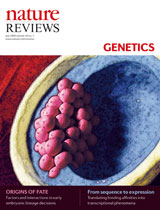
Nature Reviews Genetics is a monthly review journal in genetics and covers the full breadth of modern genetics. The journal publishes review and perspective articles written by experts in the field subject to peer review and copy editing to provide authoritative coverage of topics. Each issue also contains Research Highlight articles – short summaries written by the editors that describe recent research papers.

A mitotic inhibitor is a drug that inhibits mitosis, or cell division. These drugs disrupt microtubules, which are structures that pull the chromosomes apart when a cell divides. Mitotic inhibitors are used in cancer treatment, because cancer cells are able to grow and eventually spread through the body (metastasize) through continuous mitotic division. Thus, cancer cells are more sensitive to inhibition of mitosis than normal cells. Mitotic inhibitors are also used in cytogenetics, where they stop cell division at a stage where chromosomes can be easily examined.

Jack William Szostak is a Canadian American biologist of Polish British descent, Nobel Prize laureate, Professor of Genetics at Harvard Medical School, and Alexander Rich Distinguished Investigator at Massachusetts General Hospital, Boston. Szostak has made significant contributions to the field of genetics. His achievement helped scientists to map the location of genes in mammals and to develop techniques for manipulating genes. His research findings in this area are also instrumental to the Human Genome Project. He was awarded the 2009 Nobel Prize for Physiology or Medicine, along with Elizabeth Blackburn and Carol W. Greider, for the discovery of how chromosomes are protected by telomeres.
The following outline is provided as an overview of and topical guide to genetics:
A P1-derived artificial chromosome is a DNA construct that was derived from the DNA of P1 bacteriophage. It can carry large amounts of other sequences for a variety of bioengineering purposes. It is one type of vector used to clone DNA fragments in Escherichia coli cells.
In molecular cloning, a vector is a DNA molecule used as a vehicle to artificially carry foreign genetic material into another cell, where it can be replicated and/or expressed. A vector containing foreign DNA is termed recombinant DNA. The four major types of vectors are plasmids, viral vectors, cosmids, and artificial chromosomes. Of these, the most commonly used vectors are plasmids. Common to all engineered vectors are an origin of replication, a multicloning site, and a selectable marker.
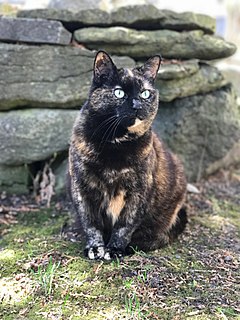
Tortoiseshell is a cat coat coloring named for its similarity to tortoiseshell material. Like calicos, tortoiseshell cats are almost exclusively female. Male tortoiseshells are rare and are usually sterile.
Microcell Mediated Chromosome Transfer is a technique used in cell biology and genetics to transfer a chromosome from a defined donor cell line into a recipient cell line. MMCT has been in use since the 1970s and has contributed to a multitude of discoveries including tumor, metastasis and telomerase suppressor genes as well as information about epigenetics, x-inactivation, mitochondrial function and aneuploidy. MMCT follows the basic procedure where donor cells are induced to multinucleate their chromosomes. These nuclei are then forced through the cell membrane to create microcells, which can be fused to a recipient cell line.











